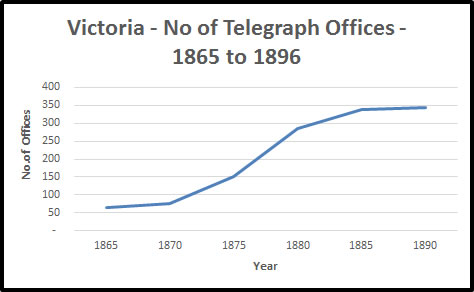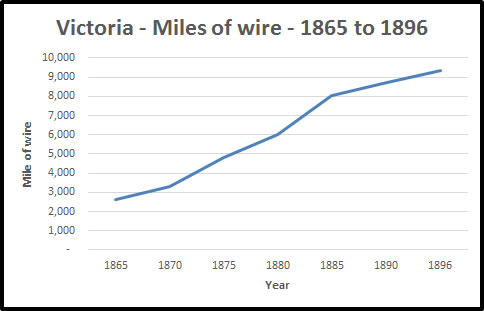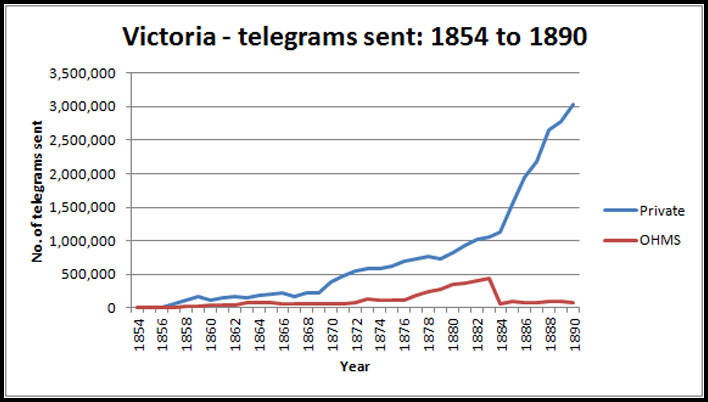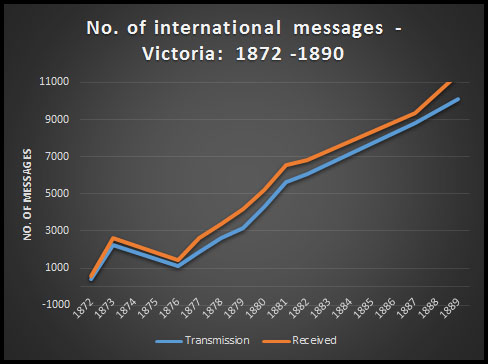Overview of developments.
- Australia 1901-1988
- New South Wales
- Queensland
- South Australia
- Tasmania
- Victoria
- Western Australia
- International
- Special aspects
Summaries are provided below for:
- construction of the major telegraph line initiatives;
- milestones in the Legislation for and the administration of the Telegraph Department in Victoria;
- the dates for new developments in telegraph forms and date stamps;
- the extent of the usage of the telegraph lines -
domestic use;
early international use.
To access copies of original documents, including Annual Reports, etc, see the list elsewhere.
Telegraph lines.| 1853 - first half | Demonstration use of the first telegraph line in the Australian Colonies - from the Audit Office to the Principal (Government) buildings. |
| February 1854 | First telegraph line - Government Offices to Wiliamstown. |
| 22 May 1858 | First line to South Australia (via Portland and Mount Gambier) operational. |
| 18 August 1859. | First line (cable) to Tasmania operational. |
| 29 October 1858. | First line to New South Wales (via Wodonga and Albury). |
| 1870 | Electric Telegraph Department merged with the Postmaster-General's Department. |
 |
 |
| The number of Telegraph Offices (excluding those at Railway Stations) inceased rapidly especially during the 1870 to 1885 period. After that, there was increasing construction of telegraph lines within the railway line spaces. | The number of miles of wire increased consistently from 1865 to beyond 1900. The telegraph was an essential part of Victorian life and it was not threatened by the telephone for many years later. |
See the overview of line construction in Victoria and the listing of Telegraph Offices in Victoria.
| April 1854 | First telegraph legislation - the Electric Telegraph Act 17 Victoria No. 22. |
| 1854 | Electric Telegraph Office created with Samuel M. McGowan as Superintendent of Electric Telegraphs, |
| February 1869 | Government decided to merge the Postal and Telegraph Departments and so remove Mr. McGowan from his position as Superintendent. |
| 1873 | Authorisation to enable stamps to pay telegram costs. |
| 1890 | Post Office Act 1890 - Part V: Electric Telegraphs (image 19 or page 2806). |
See the list of Official Reports for Victoria included in this website.
| Earliest recorded forms: | |
| Transmission form: | 26 December 1862 (VC-TO-2). |
| Delivery form: | 31 January 1856 (VC-DO-1). |
| Earliest use of a datestamp on a telegram: | 7 September 1877 at Richmond (VC-DO-8B). |
| Earliest use of a Telegraph date stamp: | 27 November 1883 at Telegraph Branch. |
| Earliest uses of a Belt & Buckle date stamp: | Clunes (1 April 1880), Collingwood (11 June 1880) and Richmond (8 July 1880). |
See the summary of telegraph stationery in Colonial Victoria:
- transmission forms;
- delivery forms - Electric Telegraph period and Post Office period;
- envelopes.
In the Report for 1887 (p. 13) it was announced that "It is desirable to adopt a system of urgent telegrams, at double rates, both locally and intercolonially"
| The graph of the use of telegrams in Victoria shows the dominance of private use over official use - despite many (unfounded) comments to the contrary.
Significant increases occurred in 1858 and 1870. A massive decrease in the use of official telegrams occurred in 1884. Basic data are included elsewhere. |
 |
In 1890, the busiest Victorian telegraph stations based on having transmitted or received more than about 50,000 messages in the year were:
| Telegraph Station | Messages transmitted. | Messages received. |
| Exchange Telegraph Office | 215,369 | 92,946 |
| Ballarat | 117,294 | 126,394 |
| Spencer Street R. S. | 78,291 | 7,264 |
| Market Street (Custom House) | 73,042 | 3,347 |
| Sandhurst (Bendigo) | 60,958 | 70,267 |
| Bourke Street East | 39,131 | 14 |
| Geelong | 37,585 | 68,813 |
| Flinders Street R.S. | 31,588 | 83 |
| Maryborough | 31,508 | 31,668 |
| Bairnsdale | 24,815 | 24,612 |
| South Yarra | 17,178 | 33,612 |
| Carlton | 16,920 | 247,800 |
| North Melbourne | 16,203 | 32,827 |
In terms of least busy stations, 144 stations had less than one message each day while six had 10 or less messages through the whole of 1890 - Eversley (nil), Tooborac Pits R.S. (1+1=2), Coburg North R.S. (2+3=5), Burnley R.S. (5+0=5), Footscray R.S. (0+6 = 6) and Linton R.S. (6+4=10).
As Victoria was the first Australian Colony to introduce telegrams, it is interesting to muse about the concepts held by people about what this completely new and rapid invention might do to their lives. Some insight is given from a snippet in Bell's Life of 8 September 1849:
"ADVANTAGES OF THE ELECTRIC TELEGRAPH. - Can that which happens tomorrow be heard of to-day? Yes - very well since the invention of the electric telegraph. Thus: the time at Exeter is twenty minutes later than the time at London; it is twenty minutes to midnight or thereabouts at Exeter. Now suppose a baby was born at London, five minutes after twelve this morning. The joyful intelligence might have been conveyed to its friends at Exeter yesterday. How funnily it would read: "Mrs. B. was safely delivered tomorrow morning of a fine healthy girl, the image of its grandmother, as infants generally are".
 |
After telegraphic connection was made to complete the line from Adelaide to Europe, the demand for the international service grew steadily - despite the high rates charged.
The graph shows the ten-fold rise in demand especially from 1876 when the reduction to 10s 6d. per word rate was introduced. The data on which the graph is based are included elsewhere. |